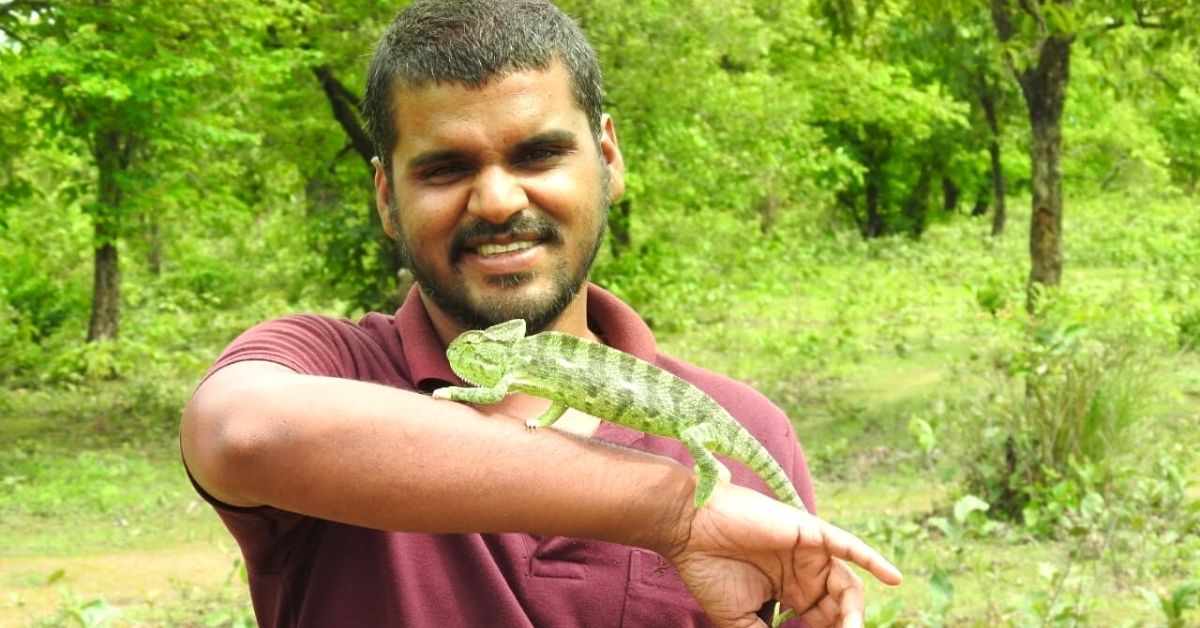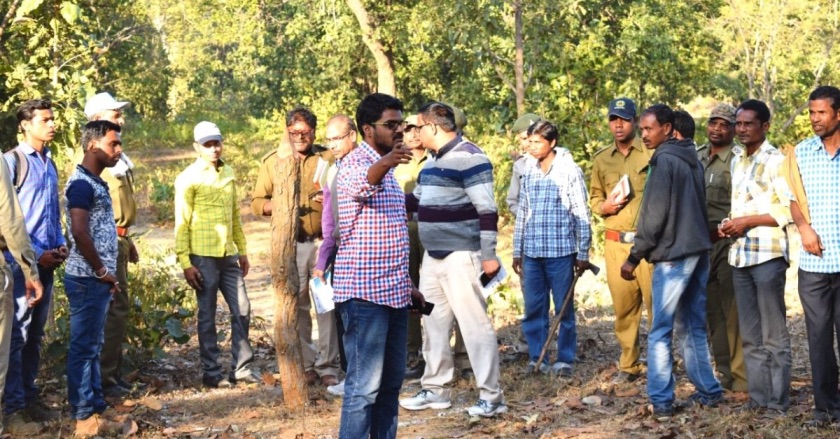Chhattisgarh Engineer Quits Job To Battle Tiger Poachers; Clears 100s of Traps
M Suraj from Chhattisgarh, along with the state forest department and NGOs confiscated over 150 animal traps from Udanti-Sitanadi Tiger Reserve to save wild cats

One evening in February 2018, M Suraj and four other members were closely monitoring tiger movement through trap cameras from a room in Udanti-Sitanadi Tiger Reserve when bad news struck. A person from the village rushed to them with a newspaper that showed a tiger skin confiscated by the forest department authorities.
It only took moments for the team to recognise that it was the same male tiger who was missing for months.
“The tiger, Bhushan, was a fully grown adult of about 10 years. We were observing his movements for the past couple of years, so the strips of the wild cat, which act as identification marks, were known to us by heart. We assumed that he wandered to another tiger corridor… It was difficult to comprehend that he was hunted down,” says 30-year-old M Suraj, a conservationist working to protect the wildlife in Chhattisgarh.
Suraj and his team went into a state of shock with few members also shedding tears. “We had a special attachment with the animal,” he explains. However, after a few weeks of grieving, Suraj learnt that the tiger had fallen prey to a trap laid for wild pig and was shot down by poachers in the chest.
“The poachers were arrested with the tiger hide but the incident helped me realise the major steps needed for wildlife conservation,” he says.
Since 2018, the conservationist with the teams from Wildlife Trust of India, state forest department and David Shepherd Wildlife Foundation has searched 300 locations of the reserve and confiscated over 150 animal traps while destroying bigger, wooden traps on the spot.
Empathy for wildlife

Suraj has always been sensitive to wild animals. And for that reason, he chose to quit his job as a lecturer in an engineering college and enter wildlife conservation.
The former mechanical engineer graduated from Durg in 2011 and pursued a comfortable job as a lecturer. On his way home one day, he saw a snake beaten to death. “This moved me so much that I decided to quit my job and rescue snakes. However, along with snake rescue operations, he slowly connected with similar groups to save spotted deers, hyenas, monkeys, leopards and birds in the tribal-dominated forest area,” he says.
Continuing the work, the man started working in tandem with the state forest department authorities. “We interacted during rescue tasks and many times the department officials sought help to save wildlife in distress,” he adds.
During one such occasion in 2016, Suraj met the then Divisional Forest Officer (DFO), Alok Tiwari who was impressed with his work. “The officer asked if I’d spend all my life rescuing snakes or would I like to do something else too. He helped me get on board with the tiger monitoring team in 2016-17 at Bhoramdeo wildlife sanctuary which shares a boundary with the Kanha tiger reserve,” he says.
Until 2018, Suraj continued with the tiger monitoring work along with the National Tiger Conservation Authority. However, when the incident of the tiger’s death occurred, his focus turned to save the animal instead.
Anti-snare walks

Suraj proposed the idea of anti-snare walks to the state forest department in a bid to identify and remove them from the forest areas. The idea tabled aimed to carry out searches in the sensitive zones and most vulnerable parts of the tiger reserve. The next step would be to remove such traps and create awareness among the locals about protecting wildlife.
In 2019, Suraj along with members of the NGO and the state forest department launched a six-month pilot project conducting anti-snare walks across the three ranges of the tiger reserve that spanned 14 villages.
Ten people comprising members from the NGOs, state forest department and representatives of tribals were included in the team. “We identified 300 sites for poaching. The sites vary according to the agricultural season. The poachers deploy the snare traps near the farms during the harvesting season, whereas during other periods, they are spotted near water bodies and along the tracks of herbivorous animals,” he explains.
The conservator says the traps get deployed between late evening hours until morning. “They are removed at dawn before any human activity like patrolling starts in the area. If the animal gets caught, it is immediately taken away by poachers. The strategy to identify the snare spots is more about understanding the psyche and characteristics of poachers. Only then it helps in identifying the spots with precision,” Suraj tells The Better India.
During their walks, Suraj says, over 150 traps made from wood, nylon, catch nets, steel wires, brake wires, motorcycle clutch wires and mouth bombs, were recovered. “There were more than 20 big snares, and in one instance we found a room filled with animal snares with the help of local intelligence. The wooden traps made in the forest were destroyed immediately,” he adds.
Bigger conservation drives

Vishnu Nair, the then in-charge of the tiger reserve, says several measures have now been started to protect and prevent the wildlife from any harm. “The important aspect of wildlife protection is to prevent the loss of life in species as it causes great damage to the ecosystem. And recovering from ecological damage takes longer. When any incident comes to light, or arrests are made for any illegal activity, the damage of the loss of species is far from recovering from it. However, strict lawful action can act as a deterrent for future incidents,” he adds.
Vishnu, now a director at the Achanakmar-Amarkantak Biosphere Reserve says apart from tiger conservation by identifying and removing the traps, Suraj has played a crucial role in creating awareness among locals.
However, Suraj says that changing the perception among the villagers remains a challenge. “The majority of the villagers residing in the forest are primitive tribes and rely on forest resources for all their livelihood. It is difficult to expect them to quit hunting overnight and adopt a different lifestyle. We are working to change their perception. It is a continuous process,” he adds.
He further adds that work on a larger scale is needed to have a maximum impact. The conservator received a grant of Rs 10 lakh from The Habitats Trust in 2019. Suraj aims to utilise the money to expand anti-snare walks across 22 ranges of the national park.

Trisha Ghose, project director at The Habitats Trust, says, “Suraj plans to work on anti-poaching initiatives in the Baloda Bazar, Mahasamund and Gariyaband districts where wildlife is greatly threatened, due to poaching, particularly through the use of snare traps. Grassroots conservationists like him are a part of the local community and play a critical role in spearheading conservation work due to their unique understanding of the on-ground realities and a deep connection with the people living alongside wildlife. Such individuals are among the most important stakeholders for long-term conservation action.”
In conclusion, Suraj says, “Along with awareness, mapping the poaching zones and flagging them—according to their sensitivity—is under the anvil. The precise data of the poaching patterns and zones will help the policymakers chalk out a holistic strategy. Once the anti-snare walk model is successful, it can be replicated in other parts of the state.”
(Edited by Yoshita Rao)
If you found our stories insightful, informative, or even just enjoyable, we invite you to consider making a voluntary payment to support the work we do at The Better India. Your contribution helps us continue producing quality content that educates, inspires, and drives positive change.
Choose one of the payment options below for your contribution-
By paying for the stories you value, you directly contribute to sustaining our efforts focused on making a difference in the world. Together, let’s ensure that impactful stories continue to be told and shared, enriching lives and communities alike.
Thank you for your support. Here are some frequently asked questions you might find helpful to know why you are contributing?


This story made me
-
97
-
121
-
89
-
167











